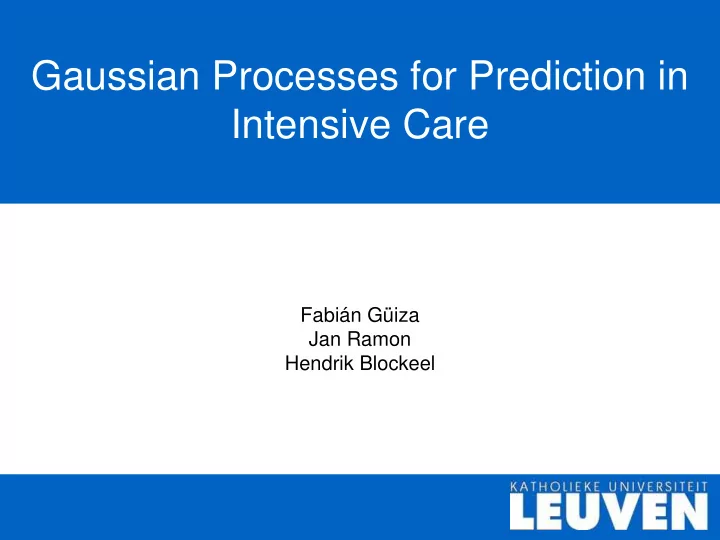

Gaussian Processes for Prediction in Intensive Care Fabián Güiza Jan Ramon Hendrik Blockeel
Introduction – Intensive Care I.C.U. Patient Intensivist Patient Information A physician analyses the data to foresee a change in the patient’s condition and to administer an appropriate treatment Treatments
Introduction – Intensive Care I.C.U. Patient Intensivist Patient Information A physician analyses the data to foresee a change in the patient’s condition and to administer an appropriate treatment It is crucial to detect clinical problems early enough so that treatments can be applied in time Treatments
Introduction – Intensive Care I.C.U. Patient Intensivist Patient Information A physician analyses the data to foresee a change in the patient’s condition and to administer an appropriate treatment It is crucial to detect clinical problems early enough so that treatments can be applied in time Of all the available data the physician makes a selection of only a few variables for prediction Treatments
Application – Intensive Care I.C.U. Patient Intensivist Patient Information MODELS Models deal with the large amount of data and make predictions (with a confidence value) of the Treatments patient’s future state
Application – Intensive Care Develop models to predict the future values of variables that are considered interesting by the physicians to determine the future state of the patient Individual Patient Characteristics •Remain constant for a given patient during I.C.U. stay •Different amongst individual patients •Define ‘normal’ or ‘typical’ state of a patient •Deviations from typical value is important information for prediction •Unknown upon admission to ICU but can be estimated from measurements
Application – Intensive Care Individual Patient Characteristics Heart Rates for different patients Normal distributions of HR for different patients
Methods – Gaussian Processes •GPs for regression have been used to model and forecast real dynamic systems, because of their flexibility and high predictive performances •Allow for multi-dimensional inputs •Assign a confidence value to predictions •Predictions can be made with noisy (uncertain) inputs, such that the uncertainty propagates to the confidence of the predicted value. •Allows for the direct use of the estimated individual patient characteristics •Predictions can not be over-confident since they are used for critical decision making processes on the physician’s part
Methods – Gaussian Processes First Experiments Prediction without IPC Prediction with IPC MSE = 4.97 MSE = 2.27
Future Work and Challenges •Define (learn) and select a set of Individual Patient Characteristics that are relevant for the prediction tasks •Verify that models are not over-confident and real values are within predicted variances •Determine appropriate time-scales for the different variables according to the predictive task •Make use of sparse methods and aggregation to deal with the large amount of data available •Preprocessing to deal with the specific type of noise for the application
Thank You
Recommend
More recommend